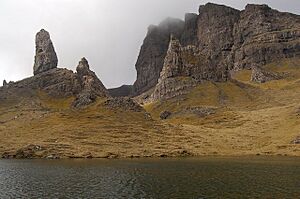Storr rock hoard facts for kids
Quick facts for kids Storr Rock Hoard |
|
|---|---|

Storr Rock, where the hoard was discovered
|
|
| Period/culture | Approx. 950 AD |
| Discovered | January 1891 |
| Place | Storr Rock, Isle of Skye, Scotland |
| Present location | National Museum of Scotland |
| https://www.nms.ac.uk/explore-our-collections/stories/scottish-history-and-archaeology/storr-rock-viking-hoard/ | |
The Storr Rock Hoard is a special collection of silver coins and pieces of silver found on the Isle of Skye in northern Scotland. This amazing treasure dates back to the 10th century, which is over 1,000 years ago! Some of the coins are called dirhams and came all the way from Central Asia.
These dirhams have Arabic script on them, which is very unusual to find in Scotland. Their presence shows us that people in the past had long and busy trade routes. They traded goods across huge distances, connecting different parts of the world.
Contents
Finding the Treasure
How the Hoard Was Discovered
In January 1891, two silver coins were found on the Isle of Skye. These coins were sent to Joseph Anderson. He was in charge of the National Museum of Antiquities of Scotland at the time. Joseph Anderson realized these coins were very important.
He decided to send people to search the area where the first two coins were found. This deeper search was a big success! They found 110 more coins. They also found 23 pieces of "hacksilver." Hacksilver is silver that has been cut into smaller pieces. It was often used like money in Viking times.
When Was the Hoard Hidden?
By looking at the coins and how they were made, experts believe the Storr Rock Hoard was buried around 950 AD. This means it was hidden during the time of the Vikings.
About the Silver Coins
What Are Dirhams?
Out of the 110 coins found, 19 were identified as dirhams. These coins were made between 895 AD and 942 AD. They came from a powerful kingdom called the Samanid dynasty. This kingdom was located in what is now Uzbekistan in Central Asia.
The dirhams all look similar. They have writing from the Quran, which is a holy book, and details about where and when they were made. Finding these coins in Scotland is very rare. It suggests that people traded valuable goods from Northern Europe for these special coins. This shows how far-reaching trade networks were back then.
The Hoard's Journey to the Museum
From Discovery to Display
The first two coins were found by a local person on Skye in 1890. They were eventually sent to the National Museum. Joseph Anderson and his team quickly understood how important they were.
The museum then organized the bigger search that found the rest of the hoard. The entire collection was given to the museum through a system called "Treasure Trove." This system makes sure important historical finds are protected. Sadly, one coin was turned into a brooch by the landowner and later lost. Today, the Storr Rock Hoard is on display. You can see it at the National Museum of Scotland in the Early Peoples Gallery.

